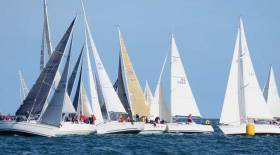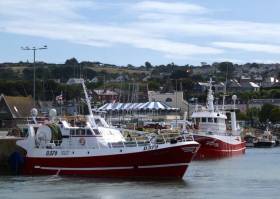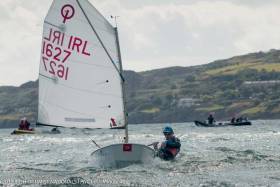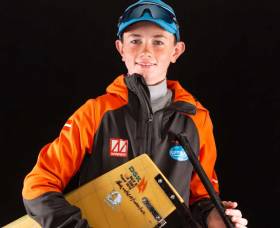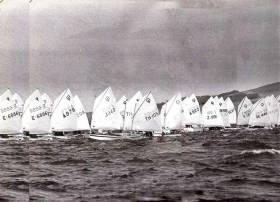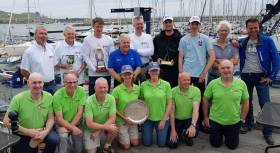Displaying items by tag: Howth Yacht Club
Beshoff Motors Autumn League in Howth Finally Brings Proper Summer to the East Coast
Bright sunshine, a good but warm sailing breeze, and summer temperatures which lasted well into the evening made Saturday’s opening of the 38th annual Autumn League at Howth Yacht Club – partnered this year by specialist car importers Beshoff Motors – into an idyllic July day which had somehow strayed into Autumn. But nobody was complaining about this inversion in normal climatic circumstance as the nine classes – with 18 sets of results when the outcome was calculated in different ways – made the best of the truly marvellous afternoon.
The fleet was mostly local, but there were contenders from Malahide and Rush too, while the enthusiastically-campaigned newly-acclaimed ISORA 2019 Champion, the JPK Rockabill VI (Paul O’Higgins, RIYC) made her way across Dublin Bay to compete - but then, as her name implies, she does have certain links with Fingal, and in a sense it was a home-coming.
As usual, it was the local One Designs, the backbone of Howth sailing, which provided the biggest fleet numbers, with the Puppeteer 22s mustering 16 entries, while the vintage Howth 17s turned out with 14 boats resplendent in their jackyard topsails.
 The Howth 17s resplendent in their topsails, with Oonagh leading 2019 National Champion Deilginis. The winner on Saturday was Rita (John Curley & Marcus Lynch), which also won the class’s first race in April 1898. Photo: Brian Turvey
The Howth 17s resplendent in their topsails, with Oonagh leading 2019 National Champion Deilginis. The winner on Saturday was Rita (John Curley & Marcus Lynch), which also won the class’s first race in April 1898. Photo: Brian Turvey
And as it is the 40th Anniversary Year for the Squibs in Howth (the word is there’s a party to celebrate this in November), the class is undergoing one of its revivals. You could do a doctoral thesis on the waxing and waning of the Squibs at different centres in Ireland, but the almost moribund Howth nucleus has suddenly shown signs of new life, and there were eight of them racing with O’Leary (S Sheahan) winning from Derek Bothwell’s Tears in Heaven while Fantome (R.McDonnell) was third.
Naturally the glamour interest in the fleet as a whole tended to focus on Class 1 and the showing of Rockabill VI, but the O’Higgins boat found herself faced with wall-to-wall north county J/109s, and they took the first three places with Rockabill VI fourth, the winner being Outrajeous (Richard Colwell & Johnny Murphy, HYC), while second was the new RC 35 2019 Champion, Pat Kelly’s Storm from Rush SC, with HYC’s Simon Knowles and Colm Buckley’s Indian, another J/109, in third.
Howth’s classic Half Tonners are in a league of their own, which tends to distort Class 2 results, and Saturday was no exception, with Nigel Biggs’ Checkmate XVIII winning from Dave Cullen’s Checkmate XV, while Mike and Richard Evans’ The Big Picture came third and another Half Ton hottie, Jonny Swan’s Harmony, was fourth. Meanwhile, the first boat from the real world was Anthony Gore-Grimes’ consistent X302 Dux in fifth.
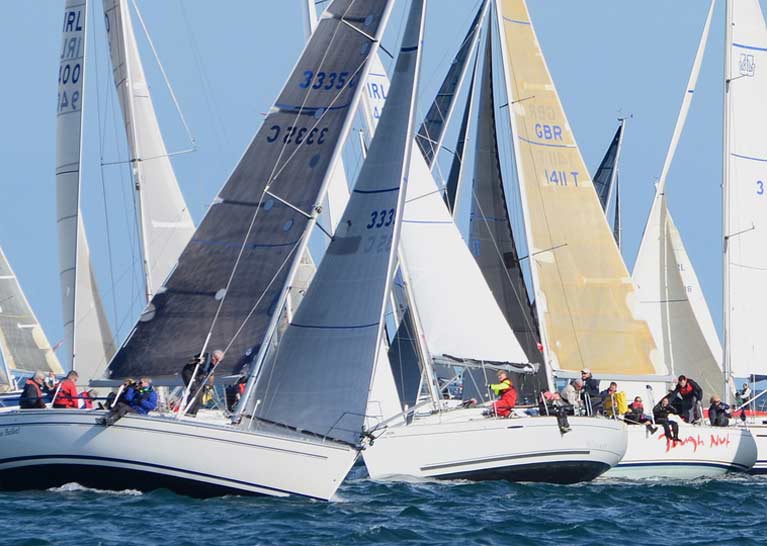 Between non-spinnaker classes and all-sails campaigners, at times the sea was crowded
Between non-spinnaker classes and all-sails campaigners, at times the sea was crowded
Class 3 saw current Sigma 33 Irish National Champion Insider getting the win for Stephen and Des Mullaney (HYC) from Vincent Gaffney’s Laser 28 Alliance II, with the Patterson/Darmody partnership’s much-modified Viking third
Non-spinnaker classes saw wins for the First 40 Tiger (Stephen Harris & Frank Hughes) and Terry McCoy & Mick Creegan’s veteran First 38 Out and About, while the J/80s saw Robert Dix (All-Ireland Helmsmans Champion of 1970, believe it or not, though he has achieved many other successes since) taking the line with his Jeannie from Jabs (J O’Dowd), while third went to Nobby Reilly with Red Cloud.
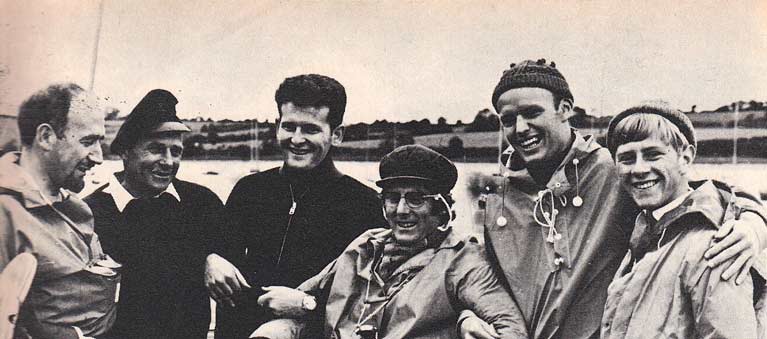 Robert Dix (right) as the youngest-ever winner (aged 17) of the Helmsman's Championship of Ireland at the conclusion of the Royal Cork Yacht Club Quarter Millenial Celebrations, October 1970. His competitors were (left to right) Michael O’Rahilly, the late Somers Payne, Harold Cudmore, Owen Delany, and Maurice Butler. Forty-nine years later, Dixie is still winning – he topped the J/80s in yesterday’s opening race of the Beshoff Motors Autumn League 2019 at Howth. Photo: W M Nixon
Robert Dix (right) as the youngest-ever winner (aged 17) of the Helmsman's Championship of Ireland at the conclusion of the Royal Cork Yacht Club Quarter Millenial Celebrations, October 1970. His competitors were (left to right) Michael O’Rahilly, the late Somers Payne, Harold Cudmore, Owen Delany, and Maurice Butler. Forty-nine years later, Dixie is still winning – he topped the J/80s in yesterday’s opening race of the Beshoff Motors Autumn League 2019 at Howth. Photo: W M Nixon
As for the Puppeteer 22s and Howth Seventeens, the racing was great at every level of their numerically significant fleets with the Seventeens being led in by Rita (John Curley & Marcus Lynch) which also won the class’s very first race in April 1898, though the word is there was a different owner back then, but in the Seventeens all things are possible. Second were the Turvey brothers in Isobel and third was HYC Commodore Ian Byrne with Eddie Ferris in Gladys.
As for the Puppeteers, they went back to the season-long situation of the two Alans – Pearson & Blay – winning with Trick or Treat, this time from Scorie Walls in Gold Dust with Ibis (S Sheridan) third, while the 2019 National Championship winner Yellow Peril (Neil Murphy & Conor Costello) had to be content with sixth.
Meanwhile, the search continues for the positional situation in Saturday’s racing of the current Irish Half-Ton Champion Mata (Michael & Darren Wright and Rick De Neve, HYC). She went out to compete with a stratospheric rating listed as being 0.989, which was out of sight compared to all the other Half Tonners which are in the 0.945 to 0.947 range. As of the time of writing, Mata has not yet landed in her true position. But as suggested on Saturday in another context, Mata should really be called Kittyhawk, as that was where the Wright brothers learned to fly, and where they also learned that flying is a doddle - it’s the landing that’s the tricky bit…..
Detailed results here
Howth: Is This The Place Where Problems Are Seen As Opportunities?
Howth Yacht Club has a fresh buzz to it these days, an electrical charge which - if they could somehow package, market and sell it at its true value - would surely provide a handy addition to club revenues. But as Commodore Ian Byrne relies on a very significant proportion of his large membership putting in hours of voluntary work afloat and ashore with dedicated time which at least begins to match his own exceptional enthusiasm for keeping the show on the road and heading in the right direction at optimal speed, the Howth Buzz isn’t a beneficial conjunction of favourable forces which could be easily put in a box of any manageable size, even if it is based on the mantra that problems should be seen as opportunities.
In tandem with the energy and sailing success at home and abroad emanating from the Club and thoroughly justifying its current position as the Mitsubishi Motors Sailing Club of the Year 2019, the harbourside and peninsular community in which HYC plays a central role increasingly finds itself becoming a tourism destination. And with good weather in prospect this weekend and the 38th Annual Howth Autumn League getting underway today with sponsorship from Beshoff Motors (of which more anon), there’s no doubt that at some stage access to the peninsula through Sutton Cross will be busy.
Time was when the safest way to travel from Dublin to Howth was as a passenger in a sailing and rowing ferry boat which departed in mid-city towards high water from steps beside Abbey Street, and sailed across the inner reaches of Dublin Bay to land at a quay of sorts in Sutton to the northwest of the current location of Sutton Dinghy Club.
There was, of course, a rough road all the way out to Howth from Dublin, going overland and then across the sandy tombolo which makes Howth a peninsula. But it was only to be used by those who customarily travelled with a properly-armed retinue, for it passed through Raheny, which once upon a time was one of Ireland’s liveliest places for highwaymen and others of ill-repute. But Howth – once you got there and were safely within the shelter of the Howth Castle’s enclosing boundary walls - was a haven of civilization, visited by the likes of Jonathan Swift and other luminaries who raised the tone of the thought and conversation about the entire place.
 Howth Castle is typical of Howth (above and below) in being something of a mixture of architectural styles. Photo: W M Nixon
Howth Castle is typical of Howth (above and below) in being something of a mixture of architectural styles. Photo: W M Nixon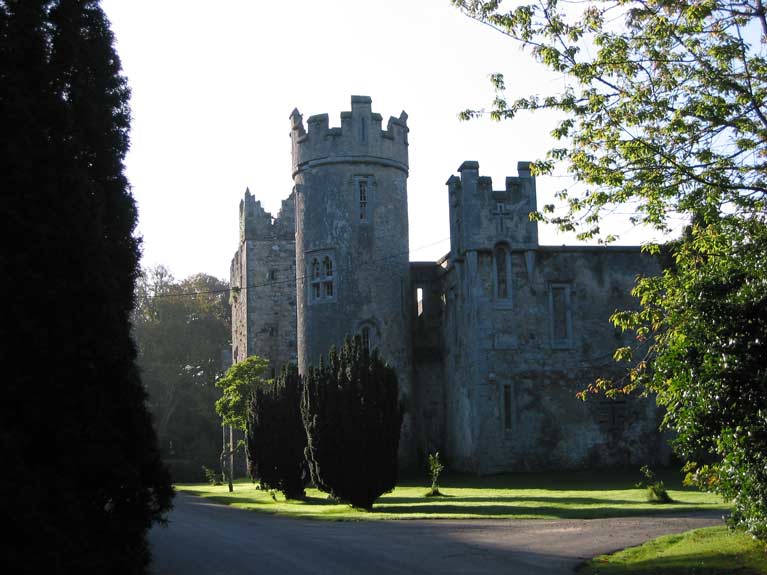
However, after Thomas Telford had completed his road from Dublin to Howth around 1823 to facilitate those using the ferry from there to North Wales and on to London (from where the road was mile-posted – with English miles too – all the way back to central Dublin), Raheny was tamed. So much so, in fact, that in recent years it has been judged one of the more quietly civilized, convenient and amenity-laden places in which to live in all Dublin.
Certainly, the Raheny and Clontarf area has, in St Anne’s Park, some of the most soothing and attractively laid-out woodlands in all Ireland. It is courtesy of the late Lord Ardilaun, whose fellow Irishmen were drinking his Guinness stout with such profitable enthusiasm that in the early years of the 20th century, he could somehow find the readies to create St Anne’s Park while at the same time splashing the cash big-time on Ashford Castle at the Mayo end of Lough Corrib in Connacht.
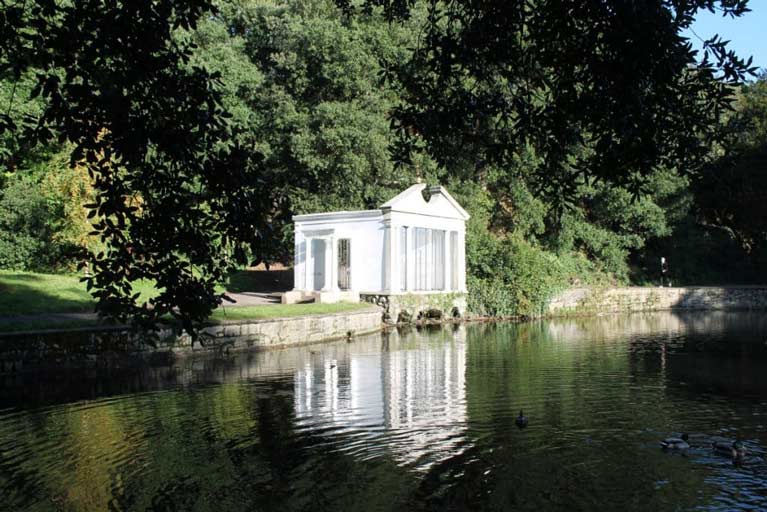 St Anne’s Park in Raheny is a peaceful and soothing place, a world away from the area’s former reputation as the haunt of highwaymen who made getting to Howth by land always challenge
St Anne’s Park in Raheny is a peaceful and soothing place, a world away from the area’s former reputation as the haunt of highwaymen who made getting to Howth by land always challenge
The result is that Raheny is now the haunt of discerning writers of distinction and others in the creative arts, whereas in Howth they’re a rough and ready lot who – even if they were the very essence of civilization as they headed towards the place – undergo some sort of Jekyll and Hyde transformation as they transit Sutton Cross.
As a result, the only conversation is about sailing and other sports, and when it’s about sailing it’s invariably soon focused on sailing success - on which they do place an almost indecent emphasis - or about the state of the harbour, which is badly in need of some serious dredging.
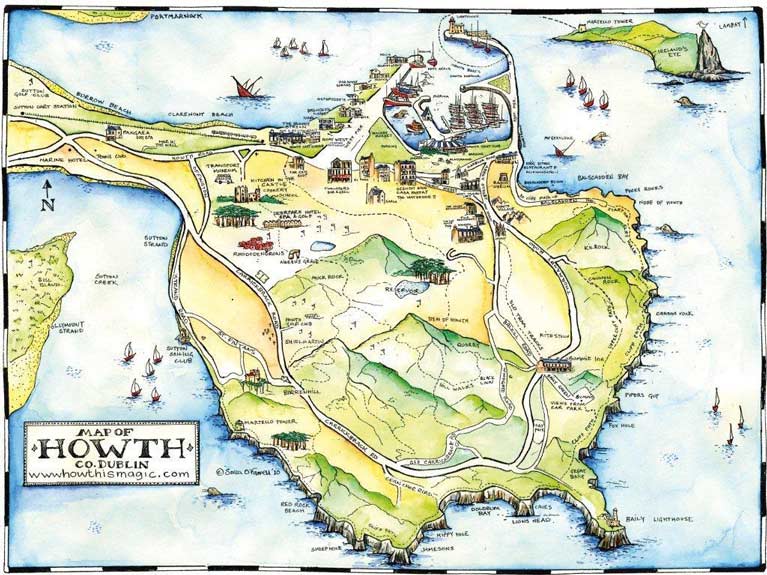 Howth as mapped for tourists. Locals walk the cliff clad in whatever they happen to be wearing, tourists arrive in full hiking gear…….
Howth as mapped for tourists. Locals walk the cliff clad in whatever they happen to be wearing, tourists arrive in full hiking gear…….
For sure, if you’re about Howth Harbour when the tide has even half risen, you’d think the place was well nigh perfect, with the 124-year-old yacht club in this increasingly good health, the sailing schools busier than ever, and the fishing fleet looking their best after the traditional August refit.
With its extraordinary selection of quayside restaurants in their quaint variety of buildings to every known design, and some unknown ones too, together with its scenic and harbour attractions, Howth is indeed - as somebody from Dun Laoghaire enviously claimed recently – a “tourism magnet”.
 Crazy but it works – this is early lunchtime on a Tuesday in September, and Howth’s extraordinary selection of restaurants on the West Pier is already busy, while fishing boats are berthed just a few metres away across the quay. Photo: W M Nixon
Crazy but it works – this is early lunchtime on a Tuesday in September, and Howth’s extraordinary selection of restaurants on the West Pier is already busy, while fishing boats are berthed just a few metres away across the quay. Photo: W M Nixon
Admittedly we who actually live in the place sometimes think that, thanks to some tomfool writers of cheapo travel guides, Howth can occasionally feel swamped by back-packing tightwads whose idea of a good day out is to take the DART to Howth, walk the incomparable cliff path, and then if they’ve any time left before heading back to their budget accommodation in the city, they can always go and look at people working around the fishing boats.
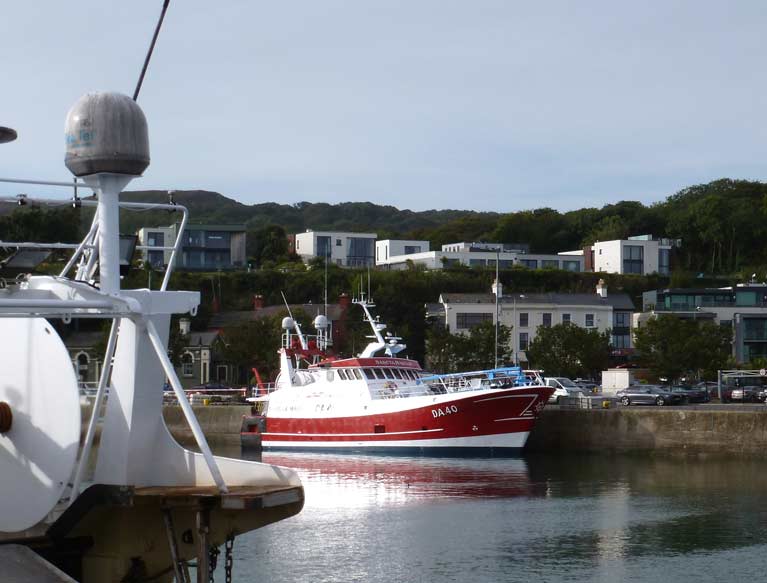 The Sancta Maria of Clogherhead in Howth for her annual refit. Being able to watch other people work makes the place even more of an attraction for tourists. Photo: W M Nixon
The Sancta Maria of Clogherhead in Howth for her annual refit. Being able to watch other people work makes the place even more of an attraction for tourists. Photo: W M Nixon
For really, there is no better way to add spice to your holiday than idly watching somebody else work, and the harder the better. Best of all is the happy recollection - as you trundle back to Hostelsville on the DART – that taking the cliff path and then watching the boat work underway doesn’t cost a cent…….
At the moment, it’s the picturesque combination of working and sailing harbour and exceptional coastal and hillside scenery with a cliff path all within easy reach of the city which seems to be the main selling point. Those of us who, back in the day, walked the cliff path in full evening wear at dawn after returning home from some May Ball or other in nearby Ireland, we do wonder a little about those determined-looking adventurers who currently disgorge from the DART in full hiking gear just to do the same….
But perhaps we should give thanks that the main thrust of the Howth package seems to be in the attractions of the here and now. We do have self-conscious re-enactments of the Asgard and Erskine Childers Howth gun-running of July 1914 now and again, but mercifully at the moment, there doesn’t seem to have been any significant tapping-in to Howth’s extraordinary literary links.
 Erskine & Molly Childers’ Asgard departing Howth at the conclusion of the successful gun-running at the end of July 1914, setting the trysail because the mainsail had been torn by over-enthusiastic help in its hoisting by the Volunteers. The Coastguard Station in the background was unfortunately demolished many years ago - unfortunate because today it would make a fascinating boutique hotel.
Erskine & Molly Childers’ Asgard departing Howth at the conclusion of the successful gun-running at the end of July 1914, setting the trysail because the mainsail had been torn by over-enthusiastic help in its hoisting by the Volunteers. The Coastguard Station in the background was unfortunately demolished many years ago - unfortunate because today it would make a fascinating boutique hotel.
Admittedly you do hear of Jonathan Swift’s links, and since then the poet Samuel Fergusson brought the place into focus, while of course Erskine Childers ingeniously wrote The Riddle of the Sands ten years before he reckoned that Howth was the perfect spot to drop a few guns ashore.
But dig a little deeper, and you’ll find that the family of William Butler Yeats lived for two years in the early 1880s in a tall damp and cold house (of which his sisters constantly complained) on the Howth waterfront, a house which Mick Hunt has since brilliantly transformed into a bright and warm and cheerful home. Then too, not only does a central scenes from Joyce’s Ulysses feature Howth, but as well one of the great Howth characters, Judge Boyd whose son Herbert designed the ever-young Howth 17s in 1897, was named-checked in Ulysses as the originator of the old Dublin saying: “It wouldn’t break Boyd’s heart”. But as for the precise origin of that, well, you’ll just have to finally finish reading Ulysses with real concentration to find out where it applies.
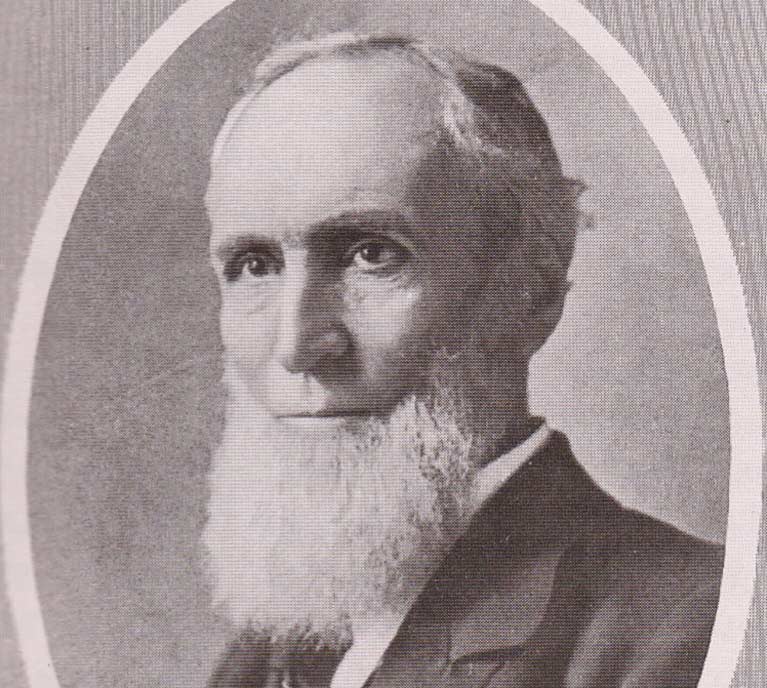 A pioneer of sailing from Howth, Judge Boyd was such a noted Dublin character that he was name-checked in Joyce’s Ulysses
A pioneer of sailing from Howth, Judge Boyd was such a noted Dublin character that he was name-checked in Joyce’s Ulysses
At a more modern level, J P Donleavy’s classic The Ginger Man has its hero living for a while in a clifftop house at Balscadden in Howth, a house under which storms crashed in caves with a hollow roar. One morning, in dire financial straits in this house, the Ginger Man cut a pale pink blanket into scarf-like strips, adorned himself with one of those strips in order to pass muster as a Trinity Pink and strode with totally artificial confidence and his best efforts at a West Brit accent into Findlaters, the up-market grocery store beside Howth Harbour, where he conned his way into opening an account in order to fill the larder back up on the cliff.
 Findlaters of Howth – connected both to The Ginger Man and the Race Programme of Howth Sailing Club
Findlaters of Howth – connected both to The Ginger Man and the Race Programme of Howth Sailing Club
These days, Findlaters is the noted pub with restaurants which is the flagship of the Wright hospitality conglomerate, and the Wright brothers Michael and Darren are into the sailing with various international ventures (again more anon), while at home they campaign the classic Half Tonner Mata, which took the Irish National Title in the Half Ton Championship at Kinsale at the end of June, while Darren’s son Rocco is, of course, a young star in the Optimist class at international level, having taken tenth at the Worlds in Antigua in July, and cutting a swathe to the podium in the Optimist scene in Europe.
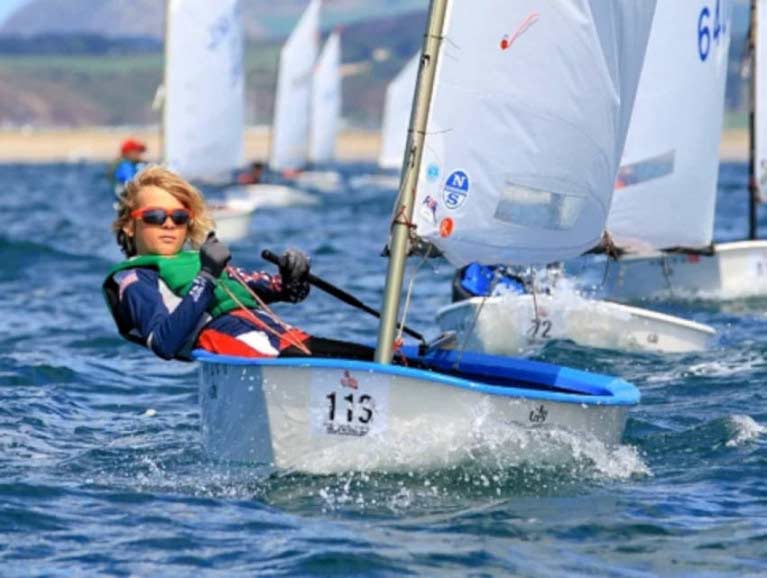 Rocco Wright - his tenth overall at the Optimist Worlds in Antigua in July was the highest placing ever obtained by an Irish helm
Rocco Wright - his tenth overall at the Optimist Worlds in Antigua in July was the highest placing ever obtained by an Irish helm
But for old Howth fans, the truly wonderful sailing connection to Findlater’s is that when the new Howth 17 Class set its sailing rules for its first season in 1898, it stated: “The time to be taken from Findlater’s Clock”. In pre-1916 Ireland, time was a very local affair, and the conspicuous but now long-gone clock on the front of Findlater’s was a blessing for the race officers of the recently-formed Howth Sailing Club and its new class.
So with untapped historical and literary connections, maybe at the moment, we’re only looking at a trickle of small-spending Howth visitors compared to what the place might attract. Imagine being like Venice and Dubrovnik, trying to find polite ways of keeping them out…..
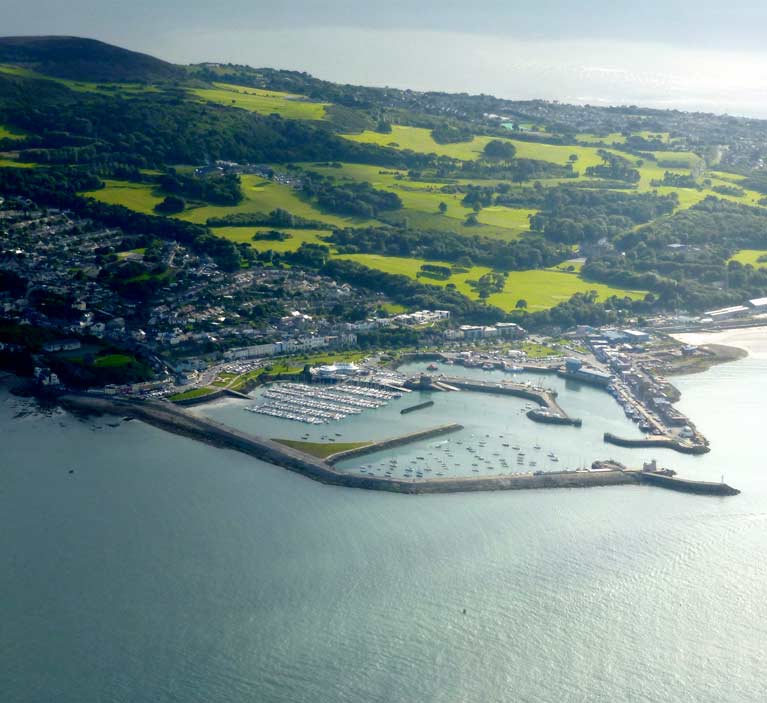 Ripe for development? Howth Harbour with the golf courses and castle (lower right) beyond. It is expected that the new Tetrarch hotel will be built up the hill on the site of the moth-balled Deerpark Hotel (middle left). Photo: W M Nixon
Ripe for development? Howth Harbour with the golf courses and castle (lower right) beyond. It is expected that the new Tetrarch hotel will be built up the hill on the site of the moth-balled Deerpark Hotel (middle left). Photo: W M Nixon
That said, it has to be admitted that many visitors to Howth are ready and willing to spend, and with the St Lawrence family now exiting Howth Castle after a brief occupation of 842 years, who knows but what a new high-end hotel created by the Tetrarch think-tank in the castle grounds will provide to make the best of the incomparable outlook from the hill. Certainly there will be those who will be able to take the long view, for after all we still have four families in Howth of centuries-old Danish descent – the Harfords, the Ricards, the Thunders and the Waldrons – who were here before the St Lawrences arrived.
In those weighty tomes, the Saga of the Harfords, the Road of the Ricards, the Trail of the Thunders, and the Way of the Waldrons, the advent of the St Lawrences in Howth will be seen as no more than a passing incursion, maybe worth no more than a chapter or two. But before the occupants of the castle take their departure, let it be said that it isn’t really true to claim that the St Lawrences were of an old Norman family. They took the name St Lawrence because they captured Howth on St Lawrence’s Day, August 10th 1177, in a private-venture offshoot from the Norman invasion of Dublin. They did it in the Battle of Evora, aka the Battle of the Bloody Stream, right beside where the pub of the same name – which is also the DART station, but that’s Howth for you – now stands.
 The difference between their railway stations speaks volumes about the difference between Dun Laoghaire and Howth. While Dun Laoghaire Station is a very formal building designed by John Skipton Mulvaney and now used as a fine dining restaurant, Howth Station (above) exudes good cheer from a standard Great Northern Railway design, and it is also a pub and eaterie known as The Bloody Stream in commemoration of the effects of the Battle of Evora nearby in 1177. Photo: W M Nixon
The difference between their railway stations speaks volumes about the difference between Dun Laoghaire and Howth. While Dun Laoghaire Station is a very formal building designed by John Skipton Mulvaney and now used as a fine dining restaurant, Howth Station (above) exudes good cheer from a standard Great Northern Railway design, and it is also a pub and eaterie known as The Bloody Stream in commemoration of the effects of the Battle of Evora nearby in 1177. Photo: W M Nixon
The main man in this in this pivotal little skirmish was one Tristram Armoricus from Armorica, the Place-by-the-Sea, as the long-gone Romans had called Brittany. He was a war-and-plunder machine with a horse, sword, and lance for hire, whose best reward was likely to be any place he could capture, a fighting man who had pledged his loyalty to the Norman invasion in Rennes Cathedral in Brittany, and had joined the preparing Norman invasion forces of Strongbow and his chums in southwest Wales direct from Brittany. Thus the first St Lawrence was Breton, and probably had much more Celtic blood than those of Danish extraction whom he vanquished in Howth.
But that’s really neither here nor there in modern Howth, which has people from everywhere. Some of them admittedly have the slightly bewildered look of people who, having found their way across the narrow gap which gives access to the place and ensures its peninsular status, have been unable to find their way out again.
Others have learned that at certain times, the best way to reach Howth or leave it is in the old pre-Telford style, by boat. But they too may have a slightly bewildered look from time to time, for they may be wondering why - as Howth’s harbour users have fulfilled their side of the deal with the official authorities by making the best possible use of the harbour - why haven’t the authorities shaped up to their part of the bargain by giving the place a much-needed dredging?
 Howth Harbour at low water. When this photo was taken in 2012, it was at a time of drought, and harbourside green spaces and trees were suffering. The silting was already a problem, but less so than it is now.
Howth Harbour at low water. When this photo was taken in 2012, it was at a time of drought, and harbourside green spaces and trees were suffering. The silting was already a problem, but less so than it is now.
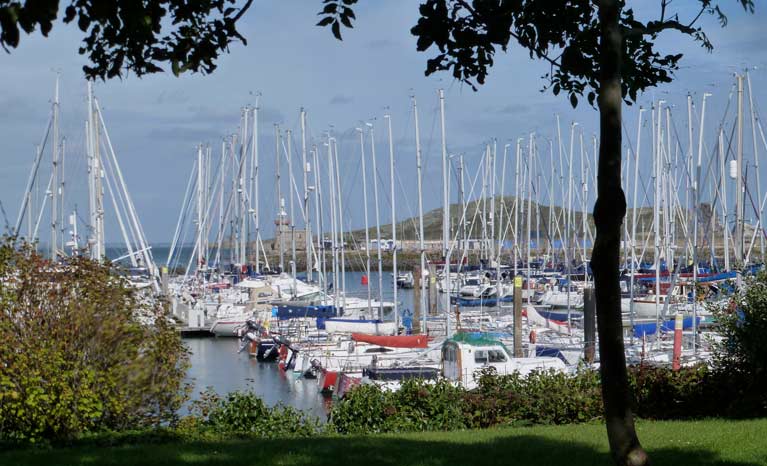 Howth Marina as it is today. One of the “happy accidents” in the creation of the modern harbour is the amount of waterside greenery, shrubbery, and grassy spaces. This is in marked contrast with Dun Laoghaire, where the only accessible green space close beside the harbour is the area of grass between the Royal Irish YC and the Irish Lights complex. Photo: W M Nixon
Howth Marina as it is today. One of the “happy accidents” in the creation of the modern harbour is the amount of waterside greenery, shrubbery, and grassy spaces. This is in marked contrast with Dun Laoghaire, where the only accessible green space close beside the harbour is the area of grass between the Royal Irish YC and the Irish Lights complex. Photo: W M Nixon
It was 1982 when the basic harbour shape as we now know it was virtually completed after several years of massive work and some very total disruption of village life. Yet in the 37 years since, there has only been some minor dredging, such as removing a rock in the marina entrance which had somehow been overlooked, but which was soon discovered in bone-shaking style as yachts became bigger and slightly deeper.
So that’s 37 years lacking in the most basic routine maintenance needed for a harbour which, as it is set in a sandy coastal area and has strong tides pouring past its entrance, has always been liable so silting. So much so, in fact, that in times long past the fairly frequent visits of the Government bucket dredger Sisyphus (they’d a way with words in those days) was taken for granted.
Except for the increasingly urgent matter of depth reduction, Howth is an excellent harbour. Maybe that’s the problem. Above the surface, to the casual observer, it all looks world class, and under Harbour Master Harry McLoughlin is certainly tidier than it has ever been. But below that gleaming water surface, all is not as it should be.
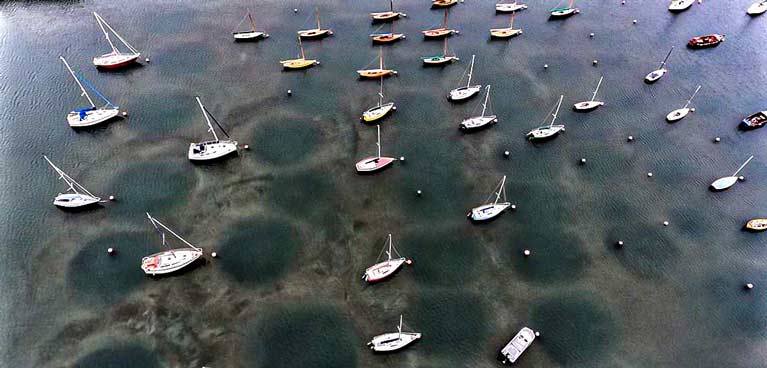 Ploughing their lonely circle……..in Howth’s outer harbour with its swinging moorings, the depth has reduced so much that even the Howth 17s – which draw only 3ft 7ins – are ploughing their own lonely circle in the soft mud at low water. Photo: Stormyphotos/Tom Ryan
Ploughing their lonely circle……..in Howth’s outer harbour with its swinging moorings, the depth has reduced so much that even the Howth 17s – which draw only 3ft 7ins – are ploughing their own lonely circle in the soft mud at low water. Photo: Stormyphotos/Tom Ryan
It wouldn’t be allowed to happen in any serious maritime country.
But as we’ve pointed out before, we may be an island nation, but we’re not really a maritime-minded country. In fact, the most successful maritime country is The Netherlands, which shouldn’t really be a maritime country at all. But the Dutch are determined when they set their minds to it, and in The Netherlands, all their many harbours are routinely dredged at least every five years, and more frequently if special local conditions make it necessary.
This might seem like home-town griping from a local, but the fact is that Howth, as it is today, is as a result of several agreements reached between Government departments – some of which have since been subsumed into other departments and may not be too aware of all their responsibilities - and the harbour users of Howth.
Put at its most basic, the Government agreed to improve the harbour to such an extent that, in effect, they provided an empty new harbour with great potential, while the users – fishermen and recreational sailors alike – agreed to invest privately in order to make the new harbour work.
Thus the fishing fleet which regularly uses Howth – not all of which necessarily regard Howth as their home port – are active in keeping the place busy as a fishing port and paying substantial dues, while also using the employment-providing revenue-generating ship repair and maintenance facilities which the government had installed.
As for the sailing community, they made an even bigger leap in the dark. In order to draw clear boundaries between commercial and leisure use, the government agreed to provide a newly-dredged basin in the eastern part of the harbour on condition that Howth Yacht Club install a marina in it at HYC’s own expense, and also build a completely new clubhouse beside it (also at their own expense) in order to move all recreational boating activity away from the new fish dock in the western portion of the harbour.
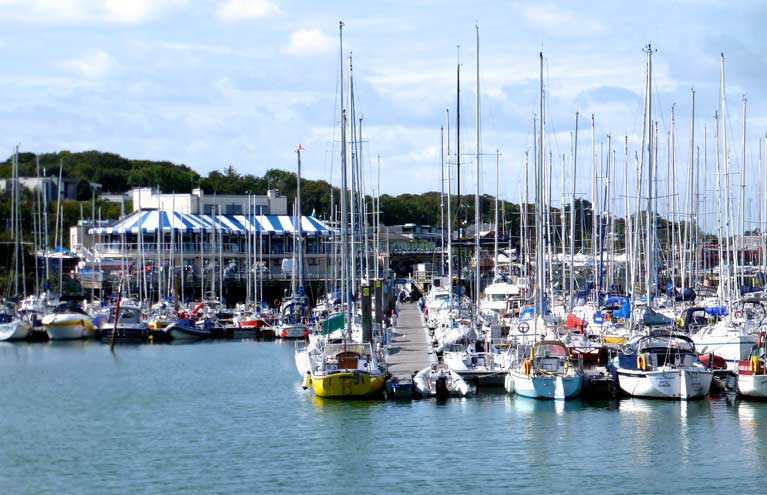 Back in the 1980s, the new Reg Chandler-designed Howth Yacht Club (winner of an RIAI medal) was designed to be part of an integral part of a complex with the marina, with the main marina walkway designed to lead directly to the principal seaward entrance to the club building. Photo: W M Nixon
Back in the 1980s, the new Reg Chandler-designed Howth Yacht Club (winner of an RIAI medal) was designed to be part of an integral part of a complex with the marina, with the main marina walkway designed to lead directly to the principal seaward entrance to the club building. Photo: W M Nixon
For those of an optimistic outlook in the sailing community, it seemed a proposal of hopeful potential. But for pessimists – just under half as the serious debates got under way – it seemed a huge leap into unknown and disaster-fraught territory, and they sought some much more modest proposal.
In the end, the vote - in a packed-out and passionate town hall sort of meeting - was in favour of the big vision. But the work was only beginning, as it has been kept going ever since, for running a yacht club in the middle of a harbour which becomes a tourism venue thanks in part to the club’s success means that in some ways the club is its own undoing. This is because the hospitality facilities which it has installed as part of the package are soon being rivalled by nimble private operators – the precursors of today’s pop-up restaurants – who could see ready new opportunities in people seeking the ocassional change of venue for eating out, and there were many of them – members and non-members alike - thanks to the new perception of Howth as a gastronomic centre, a perception which the club had done so much to create.
So as we move forwards towards 2020 - when Howth Yacht Club will be celebrating its 125th Anniversary with a very full programme while maintaining due deference to the Royal Cork’s Tricentenary – the wish-list by all in Howth at every level of interaction with the harbour is becoming clearer by the day.
High on that list would be a hope that the authorities will realise that, 32 years after it opened its new award-winning clubhouse in 1987, Howth YC is operating in a very different world. People’s behavior and their way of life generally has changed in ways large and small.
The big clubhouse is trying to function in a socio-economic environment very different from that of 1987. The business model which made the club such an economic success in its first 20 and more years no longer fits so well into changing circumstances, even if very skilled and cost-conscious management has brought some current improvement to the situation. Clearly, what the club needs is some new thinking on the part of the authorities in order to let them optimize their clubhouse’s potential without in any way diminishing its key role in the community.
 Two symbols together. The Howth 17s have come to symbolize Howth sailing, while the Fastnet Rock has become the symbol of maritime Ireland and international offshore racing. In 2003 they came together during Glandore Classics Regatta which was attended by 15 Howth 17s, when several of them – including Roddy Cooper’s Leila seen here – sailed round the Fastnet Rock. It gives some idea of the Howth Seventeens’ antiquity when it is remembered that Leila had already been sailing for five seasons when the Fastnet Rock lighthouse became operational in 1904. Photo: W M Nixon
Two symbols together. The Howth 17s have come to symbolize Howth sailing, while the Fastnet Rock has become the symbol of maritime Ireland and international offshore racing. In 2003 they came together during Glandore Classics Regatta which was attended by 15 Howth 17s, when several of them – including Roddy Cooper’s Leila seen here – sailed round the Fastnet Rock. It gives some idea of the Howth Seventeens’ antiquity when it is remembered that Leila had already been sailing for five seasons when the Fastnet Rock lighthouse became operational in 1904. Photo: W M Nixon
But right now, top of the list and with a certain urgency is the lack of depth in parts of the harbour. The requirement for dredging has of course been under discussion for a long time, and an increasingly clear programme has emerged, while a much more cohesive approach has also developed. Although the needs of the fishing fleet are obviously paramount, the fishermen’s leaders – Sean Doran and John Lynch – are in the forefront of seeing the harbour in its entirety, and when they brought Taoiseach Leo Varadkar out to see Howth and its problems for himself back in December, it was their suggestion that his tour of the harbour should conclude with cups of teas for all in the HYC clubhouse, the day rounded out by the Taoiseach meeting leading sailors and junior trainees from the club and the five neighbourhood schools which use the club’s sailing training programme.
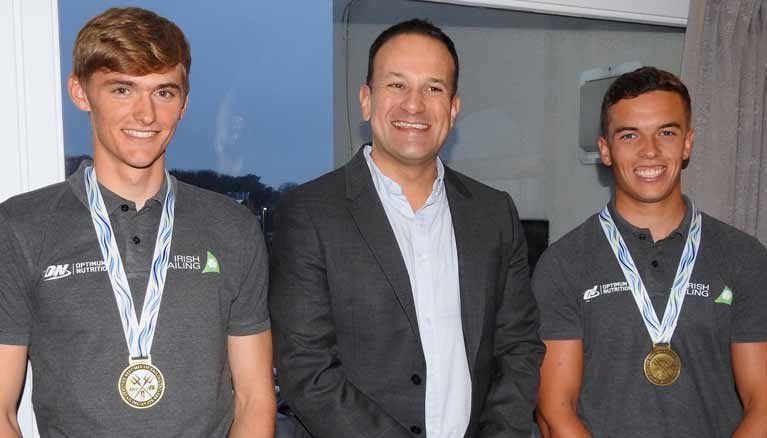 International 49er Medallists Rob Dickson (left) and Sean Waddilove (right) with Taiseach Leo Varadkar in HYC during his visit to Howth last December.
International 49er Medallists Rob Dickson (left) and Sean Waddilove (right) with Taiseach Leo Varadkar in HYC during his visit to Howth last December.
Despite the inevitable limitations placed by the increasing siltation situation, ad hoc solutions have been found around them to keep the programme moving along, and the club’s top success in running a record-turnout 11-nations Irish Optimist Nationals in August in very demanding conditions was of course not particularly depth reliant, but it certainly tested the strength and flexibility of Howh’s capacity to handle major events.
Thus ways will be found of continuing while the dredging is under way, and at the moment the best scenario timescale is that work on improving and deepening the Middle Pier’s west side for use by the fishing fleet will begin in 2020, but the major harbour dredging programme won’t start until 2021, and will last for at least 18 months.
So that’s two-and-a-half years of harbour disruption of various levels in prospect from next year (unless, of course, a messy Brexit upsets all Government finances). But for those of us who lived in the village during the massive harbour work which went on for years in the early 1980s (when the Irish economy was actually shrinking), we know that relatively speaking, this is a much smaller disruption coming down the line. Its ultimate benefit will be appreciated by all, and that cussed Howth ingenuity will find ways of keeping the harbour and its fishing and sailing functioning in one way and another.
 Commodore Ian Byrne with HYC’s Luke Turvey, one of Ireland’s leading Optimist racers who placed second overall at the 11-nation Irish Optimist Open Nationals at Howth in August. Photo Sara Lacey
Commodore Ian Byrne with HYC’s Luke Turvey, one of Ireland’s leading Optimist racers who placed second overall at the 11-nation Irish Optimist Open Nationals at Howth in August. Photo Sara Lacey
Meanwhile, a quick canter through some Howth sailing achievements to date in 2019 show the kind of pace that is being set. Laura Dillon won the UK Open National Women’s Championship, Jonny Swan’s classic Half Tonner Harmony won Class 3 in the Scottish Championship, the Wright brothers (they should call their boat Kittyhawk) won the Irish Half Ton Nationals at Kinsale with Mata, young Rocco Wright then went on to get tenth in the Optimist worlds, apparently the highest-ever by an Irish helm, Eve McMahon won the Gold in the U17 Laser Radial Worlds in Canada, Robert Dickson & Sean Waddilove won the Bronze in the U23 49er Worlds, Jamie McMahon won Gold in the U21 Laser Radial Euros, Aoife Hopkins qualified for the final play-off for the 2020 Olympic spot in the Women’s Laser Radials, Alistair Kissane won the Moth Nationals, the Howth-inspired all-Ireland J/24 Headcase with HYC’s Cillian Dickson and Sam O’Byrne on board won the J/24 Nationals on Lough Erne, the Gore-Grimes family with the X302 Dux won Class 3 at the ICRA Nats, the Sigma 33 Invader (Stephen & Des Mullaney) was top Irish boat in the extra-large Sigma 33 40th Anniversary fleet in the Volvo Dun Laoghaire Regatta, the veteran Club Shamrock Demelza (Steph Ennis & Windsor Lauden) won her non-spinnaker class at the VDLR 2019, Dave Quinn of HYC is the 2019 Irish Laser Masters Champion, Pat Kelly’s J/109 Storm (whose club affiliation Howth is happy to share with Rush SC) is the new 2019 RC35 Champion, and in that incredible Irish Optimist Nats, while James Dwyer Matthews of Kinsale was overall winner, Howth were very strongly represented in the top ten with Luke Turvey second, and the season-long rankings have Matthews (Kinsale) first, but with Rocco Wright (Howth) second and Luke Turvey third.
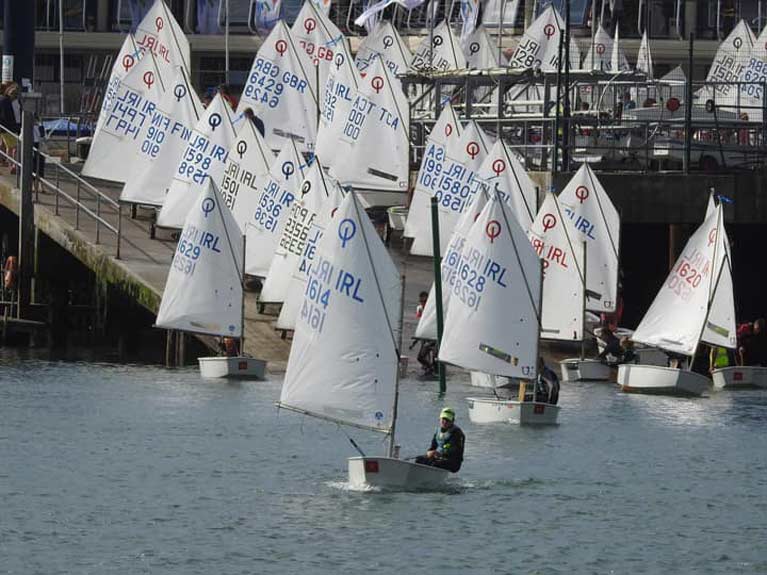 This is what 185 Optimist dinghies starting to stream seaward in a well-choreographed launching operation looks like – Optimist Nationals at Howth, August 2019
This is what 185 Optimist dinghies starting to stream seaward in a well-choreographed launching operation looks like – Optimist Nationals at Howth, August 2019
As for the local classes which are the backbone of Howth sailing, the Howth 17s had a reasonable across-the-fleet spread, though it has to be admitted that when it really mattered – and particularly in the Annual Championship –Deliginis (Massey family & Mikey Twomey) were firmly in front, while in the Puppeteer 22s, Trick or Treat (Alan Pearson & Alan Blay) were on tops generally, but Yellow Peril (Neil Murphy & Conor Costello) shone in the Annual Championship.
Looking to the future before 2019 ends, doubtless by the time it happens we’ll find that there are Howth contenders in the Middle Sea Race at the end of October, and meanwhile it has been confirmed that the Wright brothers crew, with Kieran Jameson pulling things together, have chartered a First 40 for the Rolex Sydney-Hobart Race 2019 on December 26th, a follow-up campaign to their highly-regarded third in class with the Lombard 45 Pata Negra in last year’s RORC Caribbean 600.
The largest section in the club, Howth YC’s very large Cruising Group, as ever will take a proper amount of time to assess where they’ve been and how, but they certainly do get out and about on coasts near and far. As for cruising visitors to Howth Marina, their numbers are up despite the occasional access problem, and interestingly enough they’re staying for longer, for as one of them put it: “We can be in Dublin city centre in 23 minutes by DART if we fell like it, the airport is very handy, and above all that, Howth is a very entertaining and hospitable place to be”.
So today this “entertaining and hospitable place” faces up with enthusiasm to the staging of its 38th Annual Autumn league, all made possible by the presence of the all-year security of the Marina. And it’s so very much part of the Howth story that it is being partnered by Beshoff Motors, the noted sourcers and importers of specialist cars, for the Beshoffs are very typical representatives of contemporary Howth
Most folk will be aware that Beshoff is a name which occurs fairly frequently on business facades in north Dubin and out east in Howth, yet by no stretch of the imagine is it Old Irish in any sense.
It was one Ivan Beshoff who brought the name here. He was a surviving mutineer from the crew uprising on the Tsarist Russian battleship Potemkin at Odessa in the Crimea in 1905. Having taken over the ship, the crew took her across the Black Sea to seek political asylum at Constantia in Romania, and there young Ivan Beshoff decided it as time to strike out on his own before the sclerotic Imperial Russian system came sufficiently to life to reclaim the ship.
 Smokin’ along….the battleship Potemkin - not quite a flagship for Howth, perhaps, but there are certain connections
Smokin’ along….the battleship Potemkin - not quite a flagship for Howth, perhaps, but there are certain connections
So he took off and walked west across Europe. Right across an entire continent. Then he came to the English Channel and got himself across that and walked across England and Wales until he got to the sea again at St George’s Channel and the Irish Sea. And there he managed to get aboard ship and got to Ireland where he decided he’d done enough walking. He settled in Clontarf in north Dublin and got married and became a house painter and lived well and happily until the age of 105, continuing to enjoy life such that he was still getting dressed up in style and going ballroom dancing every Saturday night past his hundredth birthday, and begetting a mighty clan who are now much more Irish than the Irish themselves.
All that explains why, when you head down the pier at Howth in search of sustenance, the first of many restaurants on your left is called Ivan’s. And it also explains why, if you feel a sudden urge to own a Bugatti or some such exotic or simply rather good car, if you don’t want to do all the internet searching and form filling and hassle that’s involved by doing it personally, then the man to go to is Jeremy Beshoff.
Thus Beshoff Motors supporting the Howth YC Autumn League is so very Howth. And I’m much happier to promote Howth’s links to Ivan Beshoff than I am to talk of our fairly tenous but still definite links to the not-very-likeable William Butler Yeats. In fact, it’s much more agreeable to reflect on the connection to the charismatic Ginger Man than to find links to the cold fish Yeats, and we can also find a link to the congenial Oscar Wilde if we’ve a mind for it. That’s how it is in Howth as we contemplate the start of the 38th Autumn League, and reflect on the impending realities of the very necessary dredging of a popular and busy harbour which is so much an integral part of our village.
Optimism prevails. Problems are seen as opportunities. Nevertheless, at the moment we’re quietly hoping that something doesn’t come up which proves to be an insoluble opportunity…
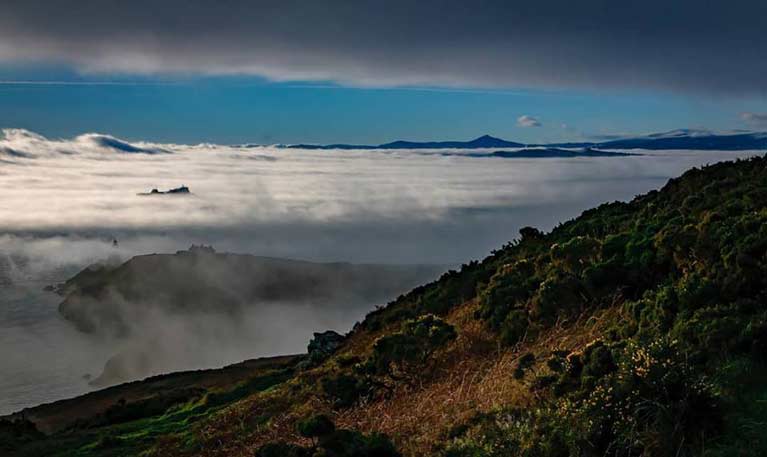 The rest of the world as seen from Howth. The view southward from the Hill of Howth early on a misty morning, with Killiney Hill and the Wicklow Hills in the distance and the bridge of the P&O Ferry Norbay just visible above the fog as she heads into Dublin Bay, bound for Dublin Port. Photo: Stormyphotos/Tom Ryan
The rest of the world as seen from Howth. The view southward from the Hill of Howth early on a misty morning, with Killiney Hill and the Wicklow Hills in the distance and the bridge of the P&O Ferry Norbay just visible above the fog as she heads into Dublin Bay, bound for Dublin Port. Photo: Stormyphotos/Tom Ryan
With all eyes on the pre-Olympics and the Rugby World Cup in Japan, Quest Howth has recently proven a big hit in the Land of the Rising Sun. While the focus in recent days may have been on the Olympic sailing at Enoshima with anticipation now shifting to Ireland playing rugby in Shizuoka in Japan next month, Quest Howth – which teaches sailing from the Howth Yacht Club marina complex - welcomed 17 pupils from an international background from the globally-renowned Tokai School at Nagoya, and introduced them to their first ever experience of sailing. And the students certainly enjoyed the fresh cool airs of Howth - unlike their hometown, which regularly hits temperatures of over 40 degrees.
As part of their curriculum with the 1962-founded Irish College of English (ICE) in Malahide, the students have a busy programme combining English lessons with cultural and sports activities. Their chosen activity was a Quest Howth Sailing Programme, which offers a different kind of learning through teamwork and individual specialities on the HYC’s own J/80 Sports boats.
 Thomas Natin is Instructor with three of the Tokai group
Thomas Natin is Instructor with three of the Tokai group
Tokai is a highly-regarded international academic school in Nagoya, renowned as an educational powerhouse which has many kids who not only study hard during the school day, but often go to cram school straight afterwards. The school itself is in an urban environment close to the famous Toyota Motor Company, so the legendary Japanese work ethic is in the very air they breathe.
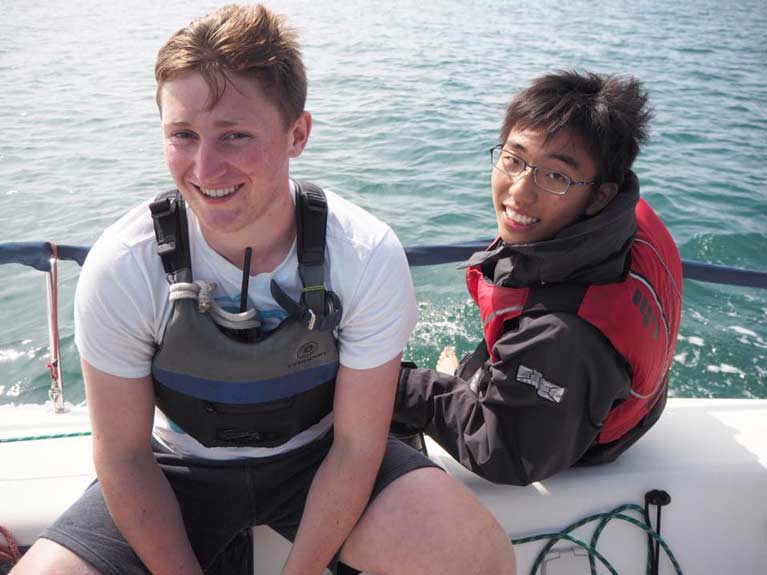 Instructor Diarmuid Brodie with a Tokai student – though most are Japanese, the school draws in pupils from all over the world, and the throughput at Quest included Russian, French, Chinese and others
Instructor Diarmuid Brodie with a Tokai student – though most are Japanese, the school draws in pupils from all over the world, and the throughput at Quest included Russian, French, Chinese and others
They work hard, so they play hard, and this is the twelfth year they have been coming to Ireland, Scotland and England to have fun and sport while developing their communication skills. Ian McIlhinney is the Social Activities Officer, and it was his idea to introduce sailing into the curriculum. He is delighted with how well the programme went, and confirmed that: “Coming to Howth to sail has been the highlight of their time in Ireland.”
 Brian McDowell, Training Manager at Howth, with Tatsuya Ito, co-ordinator of activities at Tokai School. Brian McDowell has made a remarkable contribution to the development of junior sailing in Ireland in addition to the Quest project. Last weekend, he stood down after a successful Presidency of the Irish J/24 Class Association in which the expansion of the U25 scheme – which was started in Howth by Noel Davidson in 2011 and then Fergus O’Leary in 2012 before HYC hosted the J/24 Worlds in 2013 - has come to play a central role in the J/24 class countrywide. The conclusion of the McDowell Presidency came on the weekend that one of the Howth U25 crews – skippered by Cillian Dickson – won the well-supported Irish J/24 Nationals on Lough Erne
Brian McDowell, Training Manager at Howth, with Tatsuya Ito, co-ordinator of activities at Tokai School. Brian McDowell has made a remarkable contribution to the development of junior sailing in Ireland in addition to the Quest project. Last weekend, he stood down after a successful Presidency of the Irish J/24 Class Association in which the expansion of the U25 scheme – which was started in Howth by Noel Davidson in 2011 and then Fergus O’Leary in 2012 before HYC hosted the J/24 Worlds in 2013 - has come to play a central role in the J/24 class countrywide. The conclusion of the McDowell Presidency came on the weekend that one of the Howth U25 crews – skippered by Cillian Dickson – won the well-supported Irish J/24 Nationals on Lough Erne
Speaking about Quest Howth’s sailing, Manager Tatsuya Ito, the Japanese coordinator of the trip, says that: “Brian McDowell, the Training Manager in Howth, is excellent. He is always very kind to the students and teachers. His daughter Lizzy is also a good coach, and she has been in Kyushu to teach sailing. In Howth, our boys were very excited and enjoyed the sailing and the coast with its islands.”
Lizzy McDowell with her Japanese teaching experience particularly enjoyed meeting with the Tokai boys, and hearing and learning more about their life and hometown. Risako Oya, one of the teachers with the group explained: “It was a very good opportunity for students from many countries to interact by spending time together on the boats. I was amazed to see students raise and lower sails by themselves, and also with good cooperation. I'm sure they developed a certain bond through the four-day sailing course. We really appreciate having such a good opportunity.”
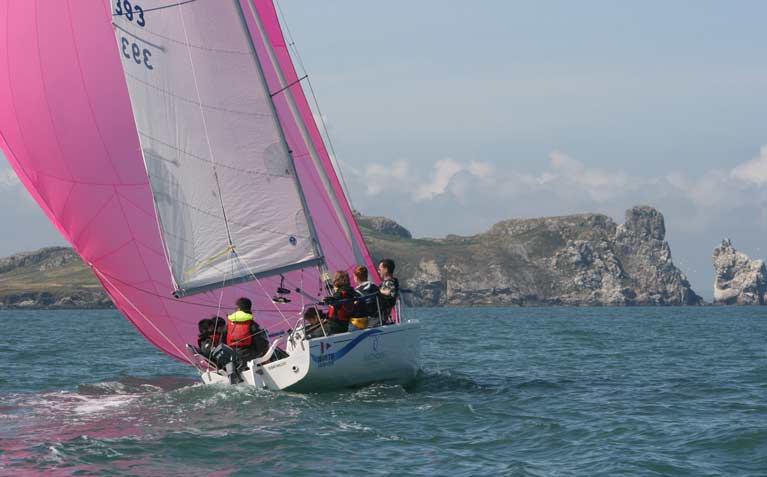 The fascinating island of Ireland’s Eye became a central feature of the Tokai school’s sailing programme at Howth……
The fascinating island of Ireland’s Eye became a central feature of the Tokai school’s sailing programme at Howth……
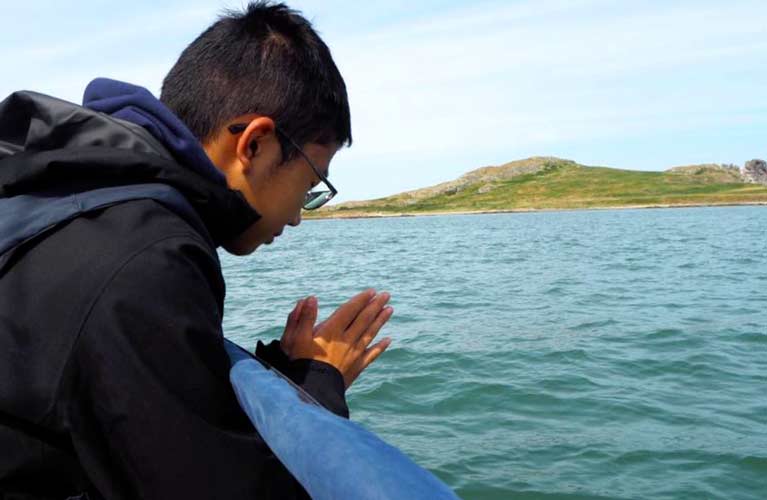 ……so much so that one of the Japanese students felt it had earned a daily prayer dedication
……so much so that one of the Japanese students felt it had earned a daily prayer dedication
Patrick Jackson of Howth, who taught in Japan at Tokai and made the introductions to ICE, says he is: “Very happy to see these guys enjoying the beautiful environment of Howth and all the fun and camaraderie that sailing offers. It’s been great to get them out on the water. And they became so involved in the life of the harbour and our coastline that we even had them actively engaged in a beach-clean……..”
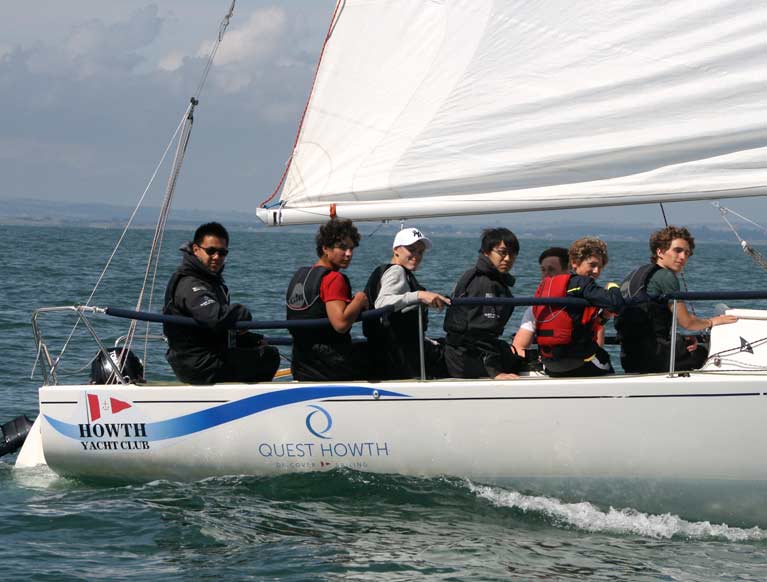 Global outlook – Quest instructor Andrew Coyle with a Tokai school trainee crew of many nationalities
Global outlook – Quest instructor Andrew Coyle with a Tokai school trainee crew of many nationalities Environmental awareness and positive action is high on the priorities for the overall programme – the Tokai students after a successful Irish beach clean, with Patrick Jackson and Andrew Ralph (Activities Leader at ICE) in middle of back row, and Tatsuya Ito, co-ordinator for Tokai, at right.
Environmental awareness and positive action is high on the priorities for the overall programme – the Tokai students after a successful Irish beach clean, with Patrick Jackson and Andrew Ralph (Activities Leader at ICE) in middle of back row, and Tatsuya Ito, co-ordinator for Tokai, at right.
The weather gods conspired against sailors on the final day of the 2019 Optimist Nationals At Howth YC.
The senior fleet were sent out first this morning on their own in a strong breeze, to race and to test the conditions for the younger fleets. This turned out be an inspired call by the race committee as the wind immediately started to build. The seniors then enjoyed a race in exhilarating conditions with capsizes and nosedives aplenty. The cream always rises to the top, and James Dwyer Matthews of RCYC / KYC finished the event in fine style with another bullet. However conditions were deteriorating with gusts in excess of 30 knots, and the decision was rightly taken to bring sailors ashore.
With the help of this final race win, James Dwyer Matthews emerged as the winner of both the Irish Nationals and Open titles, with Freddie Parkin of USA in second overall. They were followed by Luke Turvey, Rocco Wright and Johnny Flynn - all of HYC.
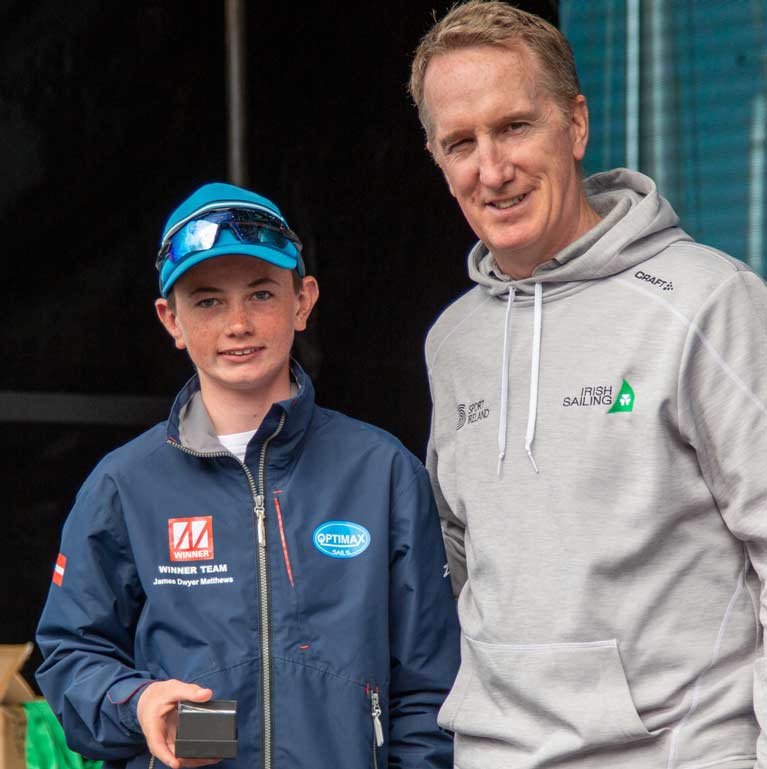 James Dwyer Matthews of RCYC / KYC receives his ISA Gold Medal from Colin Kavanagh of the ISA. James also won the UK Nationals overall in Weymouth last month
James Dwyer Matthews of RCYC / KYC receives his ISA Gold Medal from Colin Kavanagh of the ISA. James also won the UK Nationals overall in Weymouth last month
With no change in the Juniors, the event was won by Nathan Pine of Team USA. William Walsh of HYC / TBSC / MYC was the deserving winner of the Junior Irish Nationals crown from Des Turvey and Cillian Twomey, both from the host club.
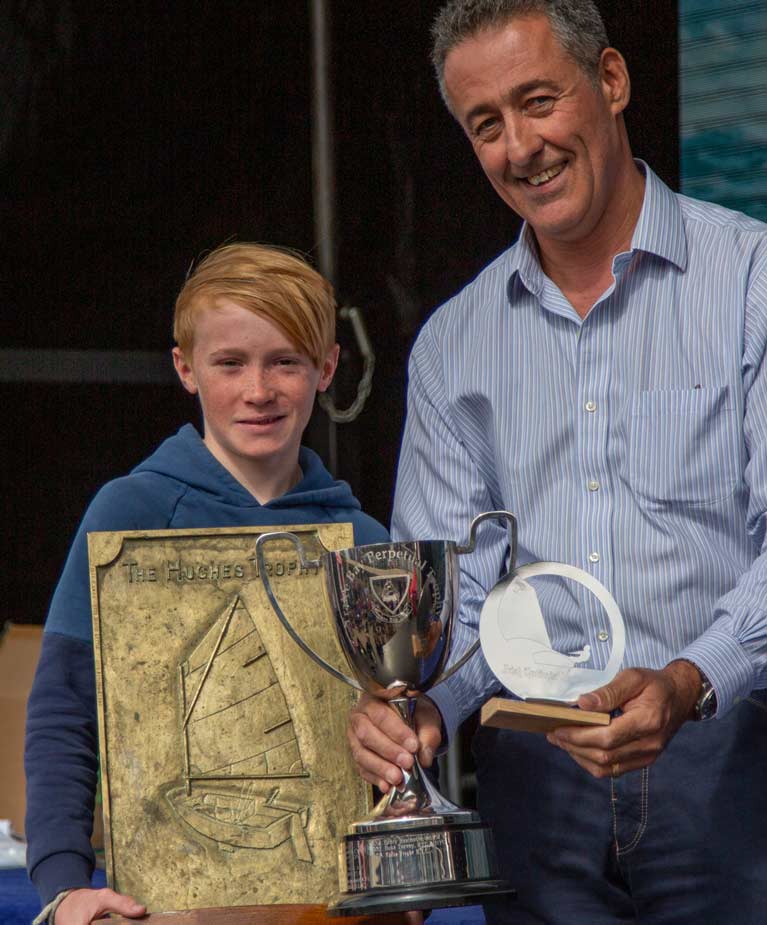 William Walsh of HYC / TBSC / MYC receives his Junior Nationals Trophy from Tim Lucas, President of IODAI
William Walsh of HYC / TBSC / MYC receives his Junior Nationals Trophy from Tim Lucas, President of IODAI
The coached Regatta Fleet was won by Conor Cronin from Malahide.
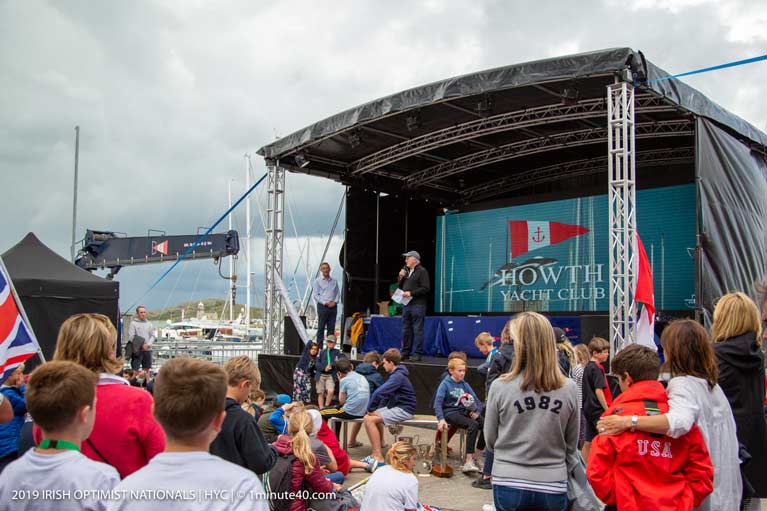 Closing ceremony of the Irish Optimist Nationals
Closing ceremony of the Irish Optimist Nationals
A very well attended closing ceremony and prize-giving followed that was enjoyed by all. The host club Howth YC under the leadership of the main event organiser Darren Wright, and aided by a 70+ strong team of volunteers ran a superb event, with the bar raised significantly for RCYC who will host the event as part of their 300 years anniversary celebrations next year.
Full results here
Saturday brought a change of fortune for sailors at the Optimist National Championships at Howth Yacht Club with champagne sailing conditions that overflowed a little for some.
The seniors were the main action of the day. They got four races in to make up for the challenges of the previous day. Freddie Parkin from Team USA is leading the field after eight races into the last day, with James Dwyer Matthews from RCYC hot on his heels and leading the Irish Nationals. The locals though have not given up the fight with Luke Turvey, Rocco Wright and Johnny Flynn - all of HYC still in contention. Sam Ledoux from Dun Laoghaire who was well in contention, suffered a broken rudder which hurt his chances - however, a 2nd discard which will happen after the next race could bring him back into the mix.
The Juniors only got two races in, as the building wind that gusted in excess of 25/26 knots was too much for some of these younger and lighter sailors. The decision was taken to send them home after two exhilarating races, but at that stage, there were probably too many boats ending up upside down. Nathan Pine from the USA is leading out the Juniors with USA & GBR sailors filling the first 4 places. William Walsh from the host club (and TBSC / MYC) is leading the Irish challenge and the Junior Nationals with a highly credible 5th position in a strong international field. He is followed in the Irish Nationals by Des Turvey and Cillian Twomey, both also of HYC and with a lot to do if they are to take the national title.
In the Regatta Fleet, Conor Cronin from Malahide leads going into the finals day, followed by Benjamin Barry of RCYC. However again the locals have not given up the chase again here, with Keelan Darby from Howth YC pushing them all the way.
Racing concludes on Sunday. Results are here
Optimist Class Gets Record Fleet for Nationals at Howth
When Howth Yacht Club hosted the 1981 Optimist Worlds, it was while the harbour was in the midst of a major redevelopment project writes W M Nixon. Yet young sailors from 26 nations provided a fleet of 130 boats, and getting them afloat each morning from a special slipway at what was then the Claremont Hotel on the beach to the west of the harbour was a major logistics challenge writes W M Nixon.
Tomorrow, the Irish Optimist Nationals get under way at Howth, and there’s a fleet of 185 boats – seven more than at Kinsale last year – and their young and sometimes very young helms come from eleven nations. Clearly, our Optimist Class is in great good health.
In 1981, some of the competitors from warmer climes complained about the rugged weather, but being the Worlds they knew they’d to take what was on offer. However, the fact of eleven nations – including a strong squad from the US - taking part in the competition over the next four days tells us much about the current strength of the Irish class, which is on something of a roll these days.
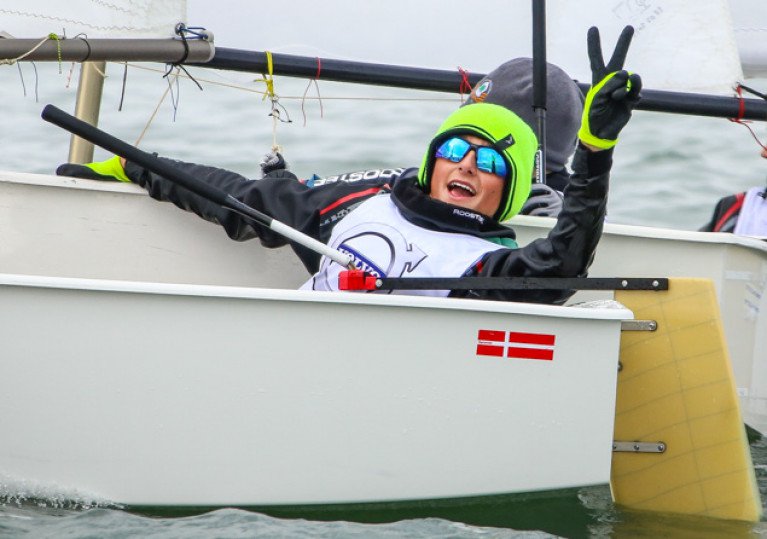 Defending champion Justin Lucas (Royal Cork YC). Photo Afloat.ie/David O’Brien
Defending champion Justin Lucas (Royal Cork YC). Photo Afloat.ie/David O’Brien
Back in the 1981 Worlds, the overall winner was Guido Tavelli of Argentina, while the top girl was Ireland’s Denise Lyttle of the Natinal YC, who was 17th in the open division. The Argentines were on top form in 1981, the last year before the Falklands War, and they also won the Team Prize, while the folk in Howth were drily informed by one of the sophisticated people accompanying the squad that your classic Argentine is an Italian who speaks Spanish and thinks he is English. This would seem to be at odds with the efforts of a certain Government minister, who spoke Italian to the Argentina-born Pope on his visit to Ireland last year, under the impression that this was his native language.
With Oppie sailors being exiled into the big bad world when they become 15, the turnover of talent is inevitably very rapid, and it’s more than difficult to keep tabs on the fact-moving production line of winners.
Defending champion is Justin Lucas who currently lists Royal Cork as his home club, and also well in the frame of serious contenders is James Dwyer Hickey of Crosshaven and Kinsale, while the host club’s Rocco Wright is progressing so rapidly in major events at home and abroad that any overall contemplation of the front runners in the Senior Fleet is akin to ranking a gladiatorial contest, and it’s a gladiatorial contest in which the obtuse August 2019 weather seems determined to make things even more difficult.
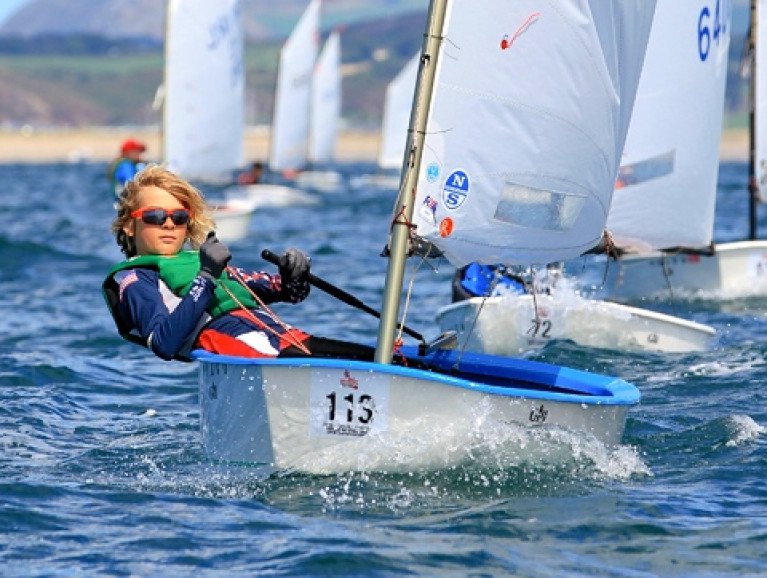 Rising star – Rocco Wright of Howth YC
Rising star – Rocco Wright of Howth YC
Meanwhile, in these times of tight budgets and shy sponsors, it’s intriguing to recall that back in 1981, after the Claremont Hotel had been returned to normal on its waterfront site and Howth Yacht Club was able to resume its battle towards having an in-harbour marina which finally opened in its first sections in July 1982, it was discovered that staging the 1981 Optimist Worlds had left HYC Events Ltd with a surplus of just over 5,000 pounds. It was used to buy a new rescue boat.
The 2019 ILCA Laser Radial Youth World Championships in Kingston, Canada concluded with a win for Howth Yacht Club’s Eve McMahon in the U17 division of the Girls fleet.
As Afloat previously reported, McMahon entered the final day in second place in the U19 category, but two race wins by the Australian sailor dropped McMahon to third overall. Clare Gorman (NYC) retained her overall fifth place.
In the Boys fleet, Tom Higgins finished strongly to gain three places on the final day to finish fifth overall, while Michéal O’Sulleabhain ended the regatta in 13th place and Jamie McMahon jumped from 34th to 19th overall.
Girls Gold Fleet:
3. Eve McMahon
5. Clare Gorman (NYC)
Boys Gold Fleet:
5. Tom Higgins
12. Michéal O’Suilleabhain
19. Jamie McMahon (HYC)
Silver Fleet:
53. James Delaney (NYC)
Bronze Fleet:
49. Sam Rutherford
Full results here
Fireball National Champions Retain Title at Howth Yacht Club
Noel Butler and Stephen Oram (NYC) have retained their Fireball National Champions title after nine races at Howth Yacht Club.
The pair scored seven first places discarding a third and a fourth to take the title in style in a three-day event which featured a good variety of sailing conditions. The event started with light and patchy winds on Friday progressing to decent if shifty breezes on Saturday and to full on wind by Sunday.
Second place was won by Niall McGrotty and Neil Cramer (SSC) who sailed consistently well and counted a string of second and third places in their scores to consolidate their second overall.
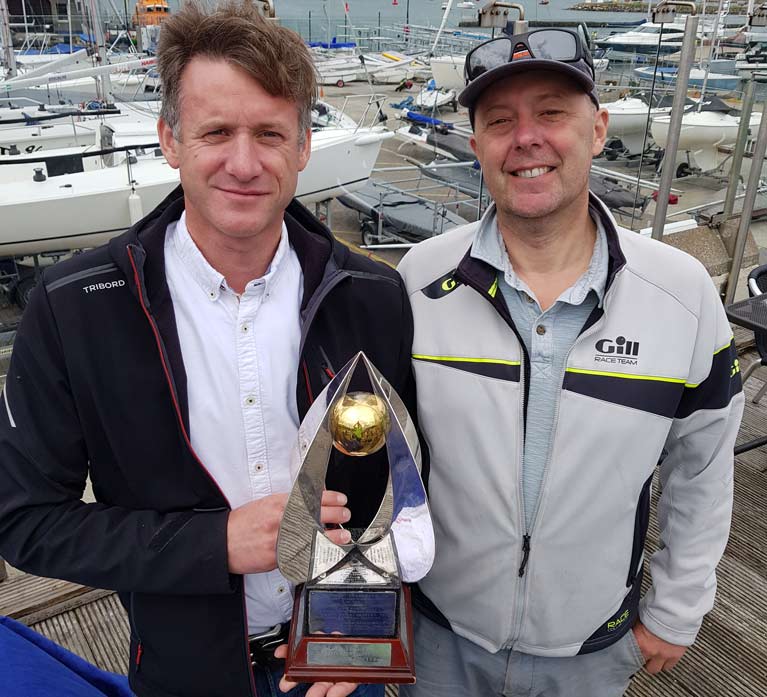 Noel Butler and Stephen Oram (NYC) Photo: Frank Miller
Noel Butler and Stephen Oram (NYC) Photo: Frank Miller
Third were the up and coming youth team brothers Daniel and Harry Thompson from Wexford who were noticeably fast on the water. Just one point behind veteran Mick Creighton with crew Hermine O’Keeffe showed he hadn’t forgotten any tricks. Winners of the silver fleet prize were Cariosa Power and Marie Barry and the Classic Boat Trophy was taken home by Nick Miller and Cearball Daly of SID in the class loan boat.
 Howth Vice Commodore Paddy Judge (left) with Niall McGrotty (right) and Neil Cramer (SSC) Photo: Frank Miller
Howth Vice Commodore Paddy Judge (left) with Niall McGrotty (right) and Neil Cramer (SSC) Photo: Frank Miller
The theme of youth and experience was a feature of the event, with veterans and new teams both jumping into the fray in the run up to the #Howth2020 World Championships in August next year. Thus we had Robin Nash (15) helming with her father Glen on the wire, the youthful Thompsons (17 and 14 respectively), and young bloods Josh Porter and helm Conor Twohig from Newtownards.
 Daniel and Harry Thompson from Wexford
Daniel and Harry Thompson from Wexford
Besides Mick Creighton Eddie Ferris made a welcome return to action with another veteran Francis Rowan on the wire.
Also returning was Owen Sinnott with Paul Horst crewing.
International Race Officer for next year’s Worlds David Lovegrove agreed to take on PRO duties for this Nationals and he and his team ran things like clockwork, seamlessly getting in three races on a difficult and patchy first day and moving marks quickly and efficiently to keep courses square throughout the weekend. David is actually a veteran Fireballer himself and his name crops up on several key trophies including the National Championships of 1967.
Friday’s painful memories of patchy shifty airs were wiped away with perfect conditions on Saturday in breezes between 10 and 18 knots and Sunday presented the most exciting conditions with full-on 20-knot breezes at times and very exciting planing conditions both upwind and down. Another feature of the event was a coaching day on Saturday run by Barry McCartin. After helping people with optimum rig set up for the conditions Barry videoed the racing, gave tips between races and gave a debrief after racing which provided much food for thought for the Irish teams competing in these same waters for next year’s Worlds.
Among the challenges on the Saturday was judging which side to take on the beat, how far to go towards shore to pick up sometimes better offshore winds and the odd wind bend and even a slightly hooked tide in the sweep of the bay.
Although everyone had their ups and downs there was no disputing Noel and Stephen’s dominance over the nine races. With a little more speed and height on the beats and carving high angles down the runs the pair remained in control for most races with just the odd breakthrough by Niall and Neil and Mick and Hermine snatching the top spots.
There were signs however that the young pairings, in particular, were improving rapidly and may present a challenge by the time the Worlds land in Howth next year. After an exciting and brilliantly run event it’s championships everyone is relishing.
Howth Yacht Club's Ewan McMahon Leads Irish Hopes of Irish Laser Olympic Qualification in Japan
Howth Yacht Club's Ewan McMahon leads Irish hopes of Irish Olympic Qualification in the Laser class after four races sailed at the Laser World Championships in Japan.
Out of the 44 countries seeking a Tokyo berth, Ireland is currently 12th in the hunt for one of five-nation places on offer this week. See overall results here
After a faltering start, Finn Lynch returned to more familiar form earlier today by placing tenth and eleventh in his flight. The results move him from 78th to 46th place overall with two more races on Saturday set to decide the Gold fleet split before the final series of six races begins on Sunday.
Conditions were windier than Thursday with a warm sea breeze of 12-17 knots.
"Finn definitely looked better this morning and he definitely performed although he is still off what he is capable of," commented Vasilij Zbogar, the Irish Sailing head Laser coach. "He needs to stop thinking of the overall result and just sail race by race."
"I tried to tell him that he doesn’t have to do anything special, just do as he knows and not over-think; if you have too many things in your head then everything can fall apart."
Meanwhile, McMahon moved up to 42nd overall after scoring a 17th and 22nd places for the day. Liam Glynn dropped from 35th overnight to 65th after two mid-fleet results.
Saturday's races will now be critical to overall Irish hopes for the championship and qualification for Tokyo 2020. After the sixth race, the top 50 boats overall will form the Gold fleet.
Once the Gold fleet is decided, the task facing Irish sailors who reach this standard will be clearer in terms of what nations have already qualified and those remaining for the five countries to be allocated at this event but already there is work to be done to move up from 12th country in the overall standings.
After Storm Emma wrought extensive destruction through the seven Howth Seventeens stored in their much-damaged shed on Howth’s East Pier at the beginning of March 2018, it was feared that several of the boats – which since 1898 have been the very heart of Howth sailing – would be written off writes W M Nixon.
But in the end only one – David O’Connell’s Anita built in 1900 by James Clancy of Dun Laoghaire – was assessed as needing a complete re-build.
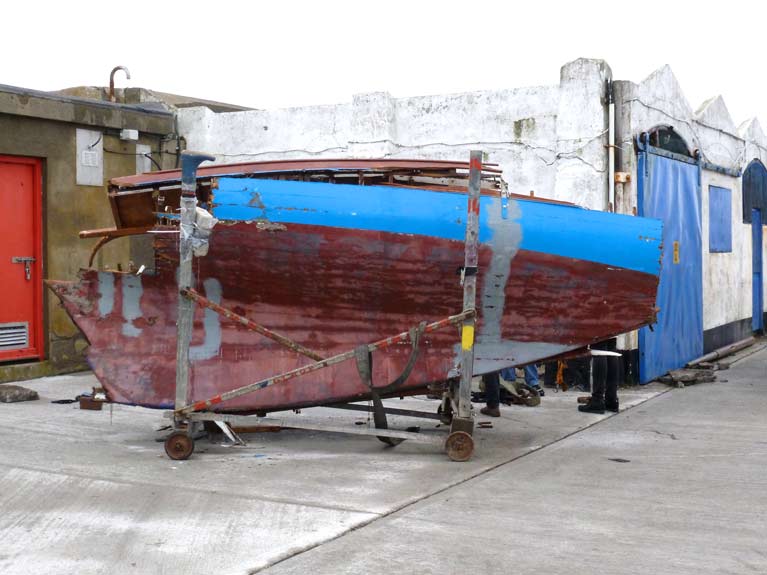 Definitely a re-build…….Anita as she was on 5th March 2018. Photo: W M Nixon
Definitely a re-build…….Anita as she was on 5th March 2018. Photo: W M Nixon
Anita is a very special Seventeen - for very many years from 1965 onwards she was the personal boat of the late Brendan Cassidy, the long-time Honorary Secretary of HYC. So the Howth Seventeen Association set about making resources available for her re-build, and the class’s action man Ian Malcolm negotiated a deal in France through the Government boat-building school scheme, whereby the customer has only to cover the cost of the materials, while the school provides the premises and the trainee labour under the direction of qualified instructors.
The boat-building schools like to test their pupils and staff through building a variety of boats. So although Skol ar Mor near the Morbihan has already built the new Howth 17 Orla, for Anita’s re-birth the Howth 17 Association went to Paul Robert’s Les Ateliers d’Enfer in Douarnenez in Brittany.
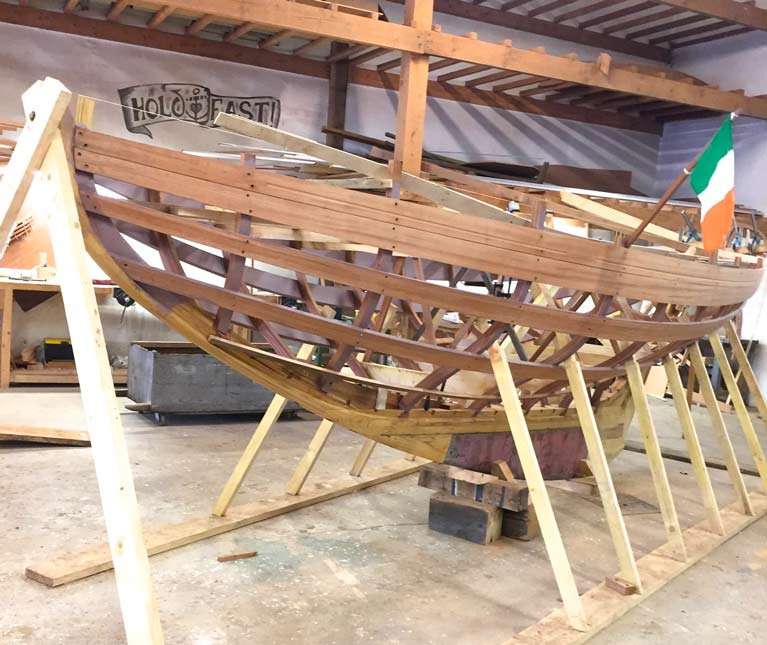 The re-born Anita taking shape in January 2019. Photo Ian Malcolm
The re-born Anita taking shape in January 2019. Photo Ian Malcolm
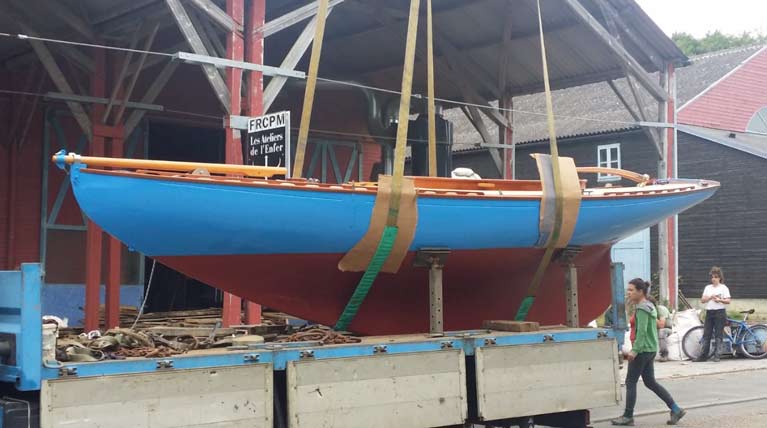 Second life. The re-born Anita emerges from the Workshops of Hell. Photo: Paul Robert
Second life. The re-born Anita emerges from the Workshops of Hell. Photo: Paul Robert
It is called the “Workshops of Hell” through its location in the midst of what was formerly the fish-smoking area of this ancient fishing port, where for centuries at least 25 massively malodourous smokeries used to make the place seem truly hellish. But today the boat-building school is a little piece of heaven, and when the re-born Anita emerged this week to spend a symbolic day afloat in the bay, she was clearly a divine bit of work.
The re-born Anita is to return to Howth via road trailing and ferry, and all being well she’ll be back in her home port by Saturday evening.
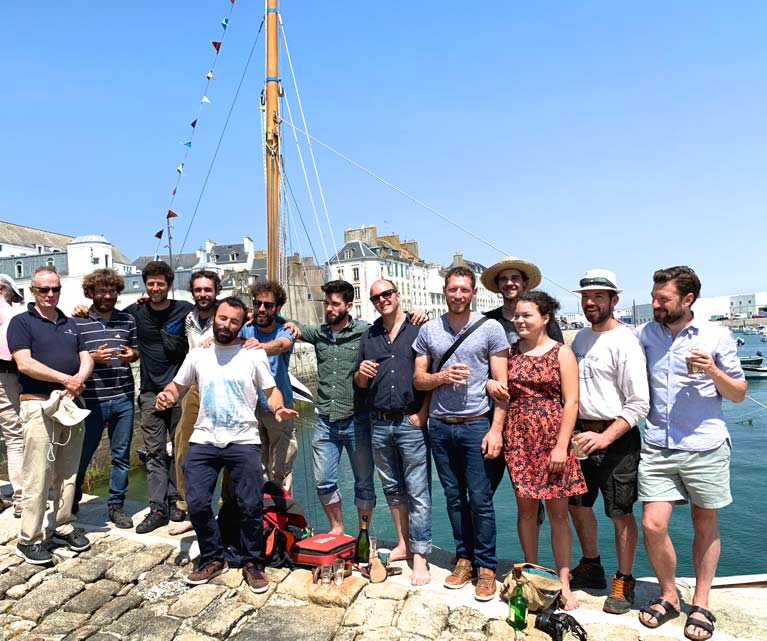 Anita would originally have been built by two men and a boy (at most) in 1900, but in 2019 it took this team of apprentices (Ian Malcolm on left) to do the job. Photo: Judith Malcolm
Anita would originally have been built by two men and a boy (at most) in 1900, but in 2019 it took this team of apprentices (Ian Malcolm on left) to do the job. Photo: Judith Malcolm



























